Local Computer File Finders - UPgrade Log
Good afternoon friends! Today we will continue our lessons with the operating room Windows system 7 and find out one more secret - how to properly configure and search for files in windows 7.
It would seem, what's wrong with that? A search engine, he is a search engine. I switched to 7 about a year ago. And to be honest, in XP I tried not to use the built-in search engine. Absolutely inconvenient. And what is needed either does not find, or finds, but the process is sometimes delayed for several hours.
I didn't really expect anything from 7. But, just the other day, this OS pleasantly surprised me. I needed to search for one file in Windows 7, I didn't remember its exact name, but I typed part of the name .. and got my file in less than 2-3 seconds. Now I use only the built-in search engine.
Indexing Service in windows 7
Microsoft developers did a pretty good job. The search tool of 7 compares favorably with the previous ones operating systems of this family not only in quality but also in search speed.
My favorite browser is Chrome, and its search engine is very similar to that in Windows 7. Search starts as soon as you enter the first characters. In addition, there is a hint system based on the history of previous requests. If there are too many results for a search query, the system suggests using dynamic filtering by various criteria - date, file size, type, etc.
The basis of such an effective work of the OS search engine is a special indexing service. It runs together with the operating system, runs in the background, and creates a special database of information about files. Updating and restoring the index in the event of any failure also occurs automatically, without user intervention.
It should be noted that the OS allocates a certain system resource for the operation of this service. For the service to work efficiently, but not to the detriment of other programs, it must be configured correctly. We will definitely talk about this today.
Instant file search in windows 7
The 7-ke provides two ways to instantly search for files.
- 1. We are looking for using the "Start" menu... Click on the "Start" button and at the bottom in the search field enter the required search query. For example "Christmas trees".

In the process of entering data, the search results will be displayed directly in the "Start" window. It should be noted that the search is also carried out on the contents of the files.
If there are too many results, and you would like to see them in more detail, click on the button “See other results”.

The Search Results window will open. The files are already sorted by type and the search query is highlighted in yellow.

You can narrow down your search. To do this, scroll the list of search results to the very end.

And in the "Repeat search in:" section, select the appropriate option.
If you assume that the file you are looking for is in the OS Library, then select this option.
If you know approximately in which folder to search, select the "Other ..." option and specify a specific folder to search.
If you want to search the Internet, then click the “Internet” button.
If you want to repeat the search on the entire computer, then click on the “Computer” button. By default, the indexer traverses all files except OS system files and program files. This improves search speed and reduces the size of the indexer base. and it's true how often we look for system files? Not often, after all. By choosing the "Computer" option, the system will repeat its search, but only more thoroughly and accordingly will take a longer period of time.
- 2. The second option for instant search is a search in the “ Windows Explorer”. The principle of operation is about the same.
Configuring the Indexing Service
- 1. Go to "Start" -> "Control Panel" -> then enter "indexing" in the search area -> select the "Indexing Options" section.
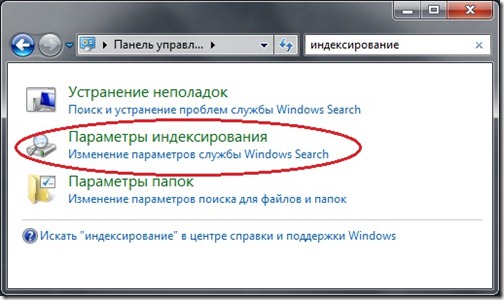
- 2. In the window that appears, you will see all the folders in which the indexing service is running. If you want to exclude a folder from the search (for example, you know that one of the sections of your hard disk used for Reserve copy, then it, in principle, can be removed from this list), click the "Change" button.

And uncheck the box next to the folder that you want to remove from the search engine. Then click the "OK" button.
- 3. Next, click on the "Advanced" button. In the window that opens on the "Indexing Options" tab, uncheck all two items. In 99% of cases, we do not need these functions, and therefore there is no need for additional load of the indexing service.

- 4. If you want to transfer the index base from the system partition hard disk to another partition in order to free free space on disk, then for this you need to specify a new folder in the Index Location section on the same tab.
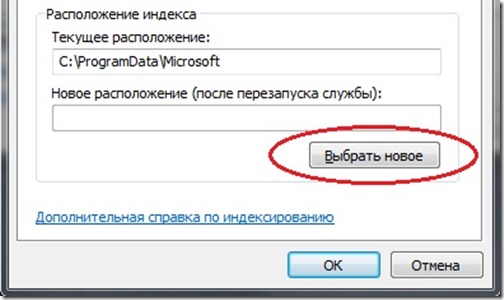
Remember to restart the Indexing Service or simply restart your computer to successfully change the location of the indexbase.
- 5. Next, go to the "File types" tab and edit the list of file types, leaving only the most essential ones (with which you work). Thus, you will significantly reduce the load on the system. By default, the Indexing Service processes almost all of the file types that it uses.
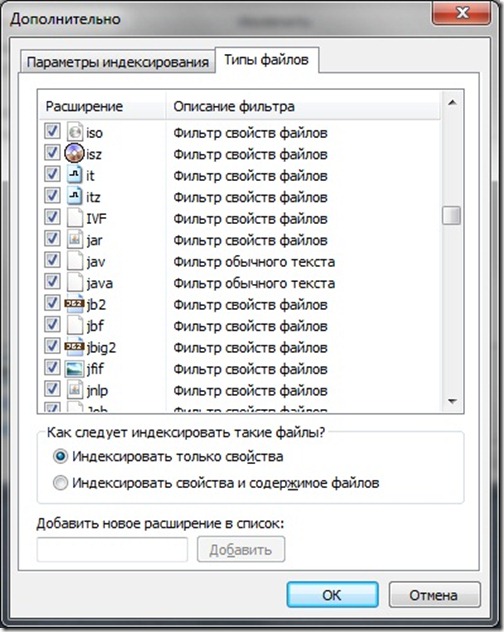
- 6. Finally, decide on how the indexing service handles files.
If you select “Index only properties”, then the indexer will only process the file name and its metadata (size, type, creation date).
If you select the option “Index properties and contents of files”, then the complete processing of the document will be performed, including its contents. This will take longer and require additional system resources, but will increase the likelihood of search accuracy.
It's up to you, my dear Reader.
- Then click "OK" and "Close".
Today we looked at the features of the Window 7 search service and how to configure it. In the next article I will share with you another interesting tool (albeit from a third-party developer) that allows you to search adapted to the Russian-speaking population, taking into account declensions and cases.
For all its merits Windows 7 cannot boast of a normal built-in function of searching for files and folders in sections. A fly in the ointment. The search in the system is so poor that it is almost impossible to find a file if you do not know the exact name of the file, until the last letter.
Third-party developers come to the rescue, as always. Company NirSoft offers a utility for advanced search of files on your computer in the environment.
The utility is called SearchMyFiles
SearchMyFiles- a powerful utility for advanced search for files and their duplicates. The program has great opportunities for filtering search and customizing the reporting of search results in accordance with your needs. With this combination, the search possibilities are almost unlimited.
Possibilities
* Search files by last modified date / keyword / file attributes
* Search for specific file / size / EXIF information
* Search by length / author / bitrate
* Search for duplicate photos of a certain file / size, etc.
* Etc., etc.
* In addition, SMF allows you to open / copy / move / delete / erase any found file.
* Search can be performed in background with minimized SMF in the taskbar.
At startup, 2 windows open at the same time. The first larger window for entering file parameters: name, extension, date of saving, approximate file size, etc. If this is a document file containing text, then you can insert a text fragment into the required field and a document with this text will be found. See the screenshot below:
The more information you enter, the more faster file will be found. When searching for a file by mask, you can insert the file extension for faster search. When testing, for example, I did not enter the file name at all, but simply inserted a text fragment into the field and indicated the extension in the mask. The file was found in 30 seconds.
The closer you specify the path to the folder with the file, the faster the file will be found. If you do not know exactly where the file is located, then indicate the root of the disk, for example C:... But in this case, the search for the file will take longer. you will have to shovel all the available folders on the disk. And it's not a fact that the folder with the desired file will be scanned first.
In general, we have set all the parameters of the file, click OK... The search for the file will start immediately.
The list of found files will be displayed in the second window. After searching from the list, select the desired file and click on it right click mice. Select the required action from the drop-down context menu.
Name: SearchMyFiles 2.35 Portable
Released: 2012
OS: Windows XP / 2003 / Vista / 7 (x86 - x64)
Interface language: Russian
Medicine: not required
The size: 1.85 Mb
Free Download: SearchMyFiles 2.35 Portable
The search engine in Windows 7 is organized slightly differently than in Windows XP, but it is no less convenient, and is performed at a much faster speed.
How to start a search
To start searching for files in Windows 7, you need to open Explorer and select the folder in which you want to search, or, if you do not know in which directory the file is located, select "My Computer". Then the search will be performed on all hard drives.
You need to search for files of any format using the search bar, which is located in the upper right corner of the Explorer in any of its windows. Keyword or a phrase must be entered on this line.
The search is performed very quickly by analogy with the request processing mechanism in any search engine. As you enter a query word, the system immediately starts scanning files and producing results with titles containing the entered characters, words, or phrases.

How to use search filters
At first glance, it may seem that such familiar filters available in XP, such as creation or modification date, file type, size and author, are not available when searching in Windows 7, but this is not at all the case.
When you enter a search query, a list of filters corresponding to the type of file you are looking for appears in the drop-down line below, the conditions of which can be set right there, in the search line. To do this, you need to click on the desired filter and set its value, for example, the change date "Last week".


How to find files of a specific type
To find a file whose format is known, such as audio, video, photo, or document, but its name, creation date, or other parameters are unknown, you can search by file type by specifying its extension in the search terms.
The documents . To search for documents in Word format, enter the characters "* .doc" (for the Word 2003 format) or "* .docx" (for the Word 2007-2010 format) in the search bar. An asterisk denotes any sequence of any characters.
For Excel files, use the characters "* .xls" (for Excel 2003 format) or "* .xlsx" (for Excel 2007-2010 format).
For files text format created using the Notepad application, you need to enter "* .txt" in the search box.
Video. To search for video files, enter the video file extension in the search bar. The most popular extensions: "* .avi", "*. Mp4", "* .mpeg", "* .wmv", "* .3gp", "* .mov", "* .flv", "*. Swf ". You can find out the file extension by right-clicking on it and selecting in context menu"Properties", where the file extension will be indicated in the "File type" line.
Audio. The most popular audio file format used on computers is MP3, and to search for them, you need to enter the characters "* .mp3" in the string.
Images and photographs. To search for pictures in the search bar, enter the most commonly used extensions of such files "* .jpg", "*. Jpeg", "* .png", "* .bmp", "* .tiff", "* .gif".
![]()
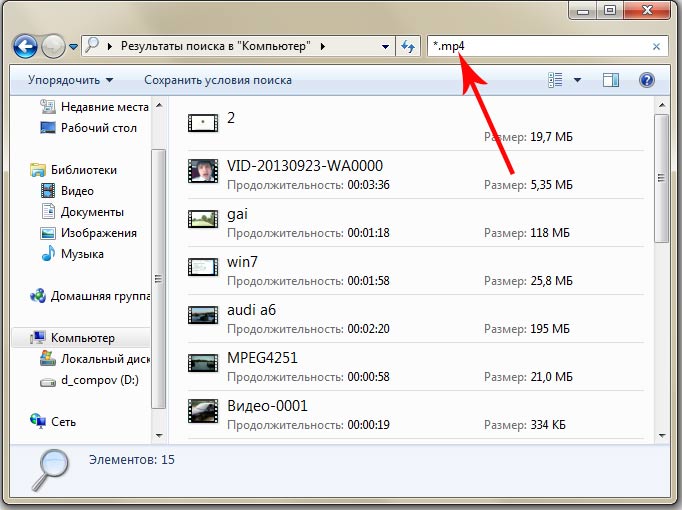
How to find a file in a large list of already found files
It often happens that the attributes of a file are unknown, or only one is known, and it is very uninformative. For example, we know that the document was created last year. However, over the past year, a huge number of documents have been created, stored in different places. It often does not seem realistic to view and check a huge number of files found based on one attribute.
To find the desired file in the list of already found files, you can use several filters at the same time, setting and changing each of them in the search process as needed. Each time a new filter is added, the selection will be repeated already in the list of found files, reducing the processing time and the number of results, which greatly simplifies the search for the very desired file.
How to find a file by content
As a rule, Windows 7 searches for files by the content of the query in the file name, and not in the text that the file contains. To find a file with the right word in its text, and not in the name, you need to make simple adjustments.
Let's say the task is to find among 500 files a document with the word "Shovel" in its content. To do this, on the control panel, click "Organize" and select in the drop-down menu, select the line "Search folder options".


It is worth noting that searching with this parameter will take a longer time, and when the need for searching through the content is no longer needed, this option should be disabled.

How to save your search terms
It often happens that files need to be searched frequently, the same search conditions are used for this, and there are several of these conditions. In order not to waste time each time entering the same search parameters, the list of these conditions can be saved.
To do this, you need to set the search conditions, wait for the results to be displayed, and upon its completion, click on the "Save search conditions" control panel, and in the window that opens, enter the file name for the repeated query, for example, "JULY 2013".
Later, when the saved set of search conditions is needed again, the desired shortcut can always be selected in Explorer and the Favorites folder under the saved name.

How to clear your search terms
By clicking on the cross at the end of the search line, you can clear the previously entered information and filter conditions that were used for the search, and the line will become empty.
Having tried search in Windows 7 several times, you can see in practice that it is practical, lightweight and fast. Now you know how to search for files in Windows 7.
Moving from Windows Vista, searching in Windows 7 only becomes more convenient and does not contain any special surprises. This cannot be said about many Windows users XP, who are just discovering day-to-day work in the system with such a convenient tool as Instant Search. Searching in Windows 7 is really easy. But, as with any search, the goal is to find what you need, and this can sometimes be difficult. With this article, I begin my story about how search works in Windows 7, how to set it up, how to search, and most importantly, how to find it.
On this page:
How search works
You've probably heard of an index, a collection of files that contain a variety of information about files and documents stored on disk. When you use search, it is the index files that allow you to quickly display the results. The index includes various properties of files, and this is not only the path, name or size. For example, for MP3 files, all tags are indexed - from author to bit rate. Office documents have data indexed, which can be seen in the file properties on the tab In detail, document content, and so on. If this search is new to you, I recommend reading a couple of Help articles for background information and searches. Minimize all windows, click F1 and in the field Search Help enter ... Search.
Indexing happens all the time - if you add, delete or change a file in a folder, it will be immediately reflected in the index.
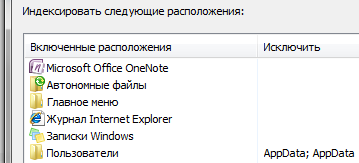
The screenshot shows the locations that are indexed by default. Therefore, if you store your documents somewhere in F: \ Documents, they will not be included in the index and quick search will not be found - they must be added to the index separately. Setting up a search will be discussed below.
Search and indexing settings
To be honest, the standard search settings are quite good, and most users do not need to change anything in them, especially if documents and files are stored in standard folders. To customize your settings, open the Start menu and search for search parameters.

So at ease we used one of the possibilities Windows search 7 - quick access to control panel items from the Start menu.
Change search options for files and folders
I will not duplicate the parameters, which are perfectly visible in the screenshot.

Pay attention to the following points:
by default, folder search searches all subfolders
in non-indexed places, only file names are searched, and compressed files are ignored
you can use language search, i.e. make up search queries in a more fluent language - for example, video last week(there will be a lot of unexpected results mixed in here, especially in localized versions)
Indexing Options and Windows Search Services
There are many more options you can tweak here. To add folders to the index, click Change.

Windows and Program Files folders are not accidentally excluded from search - they will greatly increase the size of the index, and practical benefits will be small. Programs can already be found by searching in the Start menu - after all, the main menu is indexed by default.
By clicking Additionally, you get access to two groups of settings:
indexing technical parameters
indexing options for file types
In the first one, you can add encrypted files to the index, rebuild the index (which you may need in case of problems), and set a new location for it.
For the file type (extension), you can:
include or exclude it from the index
determine if only properties will be indexed or also content
add new extension

For example, if suddenly your exchange client instant messaging preserves history in text files with the LOG extension or you just need to analyze the logs, their contents will not be indexed by default. But you can easily customize the search - just type on the keyboard log to move through the list of extensions and enable content search.
How to search
When starting a search, it is advisable to immediately imagine whether the search object is included in the index. As I said above, the index covers the user's profile - libraries, files, etc. Here you can find relatively easily required files.

But if you open the main search window and expect to find something in the Program Files or Windows folder, you might even get the impression that “the search is not finding anything” - after all, only the results from the index are displayed. We'll talk about searching in non-indexed places later, but now let's look at the general search methods in Windows 7. You can search:
from the start menu
in the main search box
in libraries
in other windows of the explorer - folders, dialogs "Open" and "Save As"
Search in the Start Menu
When you search from the Start menu, the search results show not only files and documents, but also programs and Control Panel items. Now you can safely part with the habit of the times of Windows XP - careful sorting of applications in the menu Programs... It is enough to enter the first few letters of the program name to find it. This is much more convenient, especially if you have a lot of programs installed.
If you use portable applications, just add their shortcuts to the% appdata% \ Microsoft \ Windows \ Start Menu \ Programs folder (you can create a subfolder for them). In the search results, they will appear in the group Programs.
In Windows 7, search results in the Start menu are very conveniently grouped, and the number of results in each group is immediately visible - this is an improvement over Windows Vista. As you can see in the screenshot, search by word word finds not only applications Microsoft Word and WordPad, but also offers results in other groups.

The Start menu displays several results for each group, and clicking on the group name opens a search window with all the search results in the group.
Search in the Start menu is good when you have an idea of the name of a file or its contents - the first 5 - 10 results are visible immediately, and you don't have to go far. In addition, the Start menu is indispensable for quickly accessing programs and Control Panel items using search.
Main search box
An empty search box can be opened by pressing the keyboard shortcut WIN + F... In my opinion, it has somewhat lost its meaning, since it no longer contains advanced file search capabilities. Searching in windows explorer practically displaces it from the system. It seems to me that links to help on using search or a link to this article could brighten up its dull look.

However, the main search box still carries a payload. It opens with search results by typing a query in the Start menu and clicking on the name of a search result group, or by See other results right above the search field.
Libraries
Now I will explain why I split the search in libraries and other explorer windows. Pay attention to how the search results in the library are displayed. They match the look of the files in it and are very well perceived visually. For example, for music files, album art, large song title, size are displayed, and there are also “music” options for organizing the results. This is a property of all libraries, which confirms the thesis - Windows capabilities 7 is best used together. In this case, it is a search in libraries, which has other advantages.
This is what a simple query search in the library will suggest. Music.

While in Explorer, you can organize your search results by the available file properties. The default display order is top scores, but, for example, you can sort your music files by album or genre. This feature is available alongside the traditional sorting and grouping tools of Explorer (although the latter may be new to migrants with Windows XP).
In this case, the results will display several songs from each album. You can watch all the songs on the album, and then "fold" it if the desired one is not there.
If you don't find the file you want in the current folder, you can search again:
Other explorer windows
In folders and libraries, the search field is the same as in the main window. But do not forget that the same option is available in the "Open" and "Save As" windows, which are used even by those who prefer alternative file managers.

Searching in folders is more convenient when you know the approximate location of a file or document - in this case, you will not get lost in the results. In addition, this method is useful when it is known for sure that the file is not in the index. Finally, in the "Open" and "Save As" windows, you can use the search to quickly filter the contents of a folder.
Sure you have already tried simple queries search and, perhaps, they completely suit you. However, sooner or later you will need to find the file, and a simple query will not help you. Next, I'll show you how to use the advanced search capabilities of Windows 7 to find the files you want.
What's New in Windows 7 Advanced Search
To master search, of course, you need to practice using its capabilities. In the articles on Windows 7 search, I will provide a number of examples that you can easily reproduce on your own.
If you are migrating from Windows XP, everything will be new to you in your search for Windows 7. Compared to Windows Vista, Windows 7 looks like:
Search filters
When the name of the file or the subject of the document is approximately known, it is usually not difficult to find the desired file - you just enter a partial or full request into the Start menu search. But this information is not always deposited in random access memory of the brain, and it is simply often required to set special search conditions - size, modification date, or author of the file. Windows XP had Search Assistant, Windows Vista had Filters.

At first glance, there is nothing that visually stands out in Windows 7. In fact, the filters have not gone anywhere - they just become visible when you position your cursor in the search field.
To see more filters, expand the search field - place your cursor on the separator between the field and address bar and pull to the left.

In the screenshot, you can see the standard set of filters in the main search window.
Hints
Your search queries are remembered if they were entered:
to the search box
in explorer folder or library
in the start menu (assuming you navigated to the results and not just open the file)
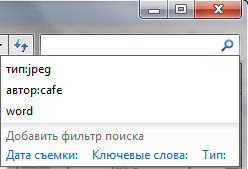
These prompts annoy some users, and they tend to turn them off immediately. And, in my opinion, they do it in vain. The tips remember not only search queries as such, but also filters searches that you asked - for example, the size or date the file was modified. The hints are very handy if you want to use the full power of Windows 7 search. The old condition can be easily changed to match the current query, and it is faster than retyping it. And an unnecessary hint can always be deleted - just select it (with the mouse or cursor) and press Delete on the keyboard.
As I said above, the new features in Windows 7 are best shared. The link between search and libraries is not only in the display of results, but also in the formation of search terms. In the next part of the article I will cover:
using filters to search libraries and mail
search in Internet Explorer 8
search in non-indexed locations
search operators
Starting to use the new system, I think you may have encountered the fact that the search for files in Windows 7 is organized a little differently, unlike other operating systems. Now I will tell you about where in Windows 7 search, and also take an example, find files in Windows 7.
Configuring Search in Windows 7
V windows menu 7 has a built-in search bar that allows you to find not only menu programs by their name, but also files and folders. I should note that not all files are searchable, but only indexed, that is, those that have been assigned a special number by the system, which is called an "index". If your files and folders are located in standard folders, then you do not need to configure indexing.
To configure, open the "Start" menu and type "search options" and in the results select "Change search options for files and folders."
In the "Search" tab, the parameters should be as in the picture below.
I do not advise you to choose a search by file name, although at first glance this seems like a good idea, in practice it will lead to the fact that the search will not only be incredibly long, but will also return a lot of extraneous results, which means it will not be effective. In this window, all settings are set optimally, there is no need to change anything.
Now, similar to the previous case, we find it in the "Indexing Options" menu. In the window that opens, click "Change" and now we can select all your data folders for indexing. Don't choose system Windows folders, select only the data that you need. You don't have to choose like Plyushkin. What if it comes in handy !?
Another useful customization feature is customization of indexing by extension. Click the "Advanced" button and select the "File Types" tab. Here you can add indexing of the contents of the files that you will search by content. For example, you want to search for documents by content. Click on "doc" and select "Index file properties and contents" at the bottom.
Now that you have everything set up, you can click "OK" and "OK" again to save the results and start searching in Windows 7 in practice!
Search in the Start Menu
V previous paragraph we easily found required programs in the Start menu using the search bar, I will only add that now that your indexing system is configured, you can search not only programs, but also all the files and folders you need, and they will be conveniently grouped by type.
To consolidate, so to speak, the material, let's repeat the steps that have already been voiced in the article. To start the search, you need to click on Start and enter the word or phrase of the item at the very bottom.
Search using Windows Explorer
In the previous chapter of the article, you could have opened the search box from the start menu, the same effect can be achieved by opening "File Explorer" or "Computer". You will see a search bar at the top right of the window. You can enter there the file name, part of the content of the files or their extension, for which you have previously configured content search.
But this is not all the possibilities. You can enter various filters there: type, modification date, author, and others. You can see the filters by placing the cursor in the search field in one of the "Libraries" folders, the wider the field, the more filters are visible. Each of the Libraries folder has its own filters, such as the length of the music file or the date the picture was taken.
You can also see that now the search results can be sorted by choosing a method in the upper right corner of the window, and by scrolling down the results to the end, you can repeat the search in other folders of the "Libraries".
And finally, I will add that a similar file search in windows 7 is available everywhere. You can open any folder and start searching in it. And this is very convenient!
For those considering switching to Windows 8:
 Differences Between GPT and MBR Partition Structures
Differences Between GPT and MBR Partition Structures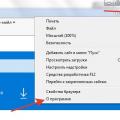 Wipe Internet Explorer cleanly
Wipe Internet Explorer cleanly Windows updates are downloaded but not installed
Windows updates are downloaded but not installed